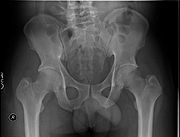
John Thomas sign
Encyclopedia

Penis
The penis is a biological feature of male animals including both vertebrates and invertebrates...
as it relates to pathology
Pathology
Pathology is the precise study and diagnosis of disease. The word pathology is from Ancient Greek , pathos, "feeling, suffering"; and , -logia, "the study of". Pathologization, to pathologize, refers to the process of defining a condition or behavior as pathological, e.g. pathological gambling....
on an x-ray
X-ray
X-radiation is a form of electromagnetic radiation. X-rays have a wavelength in the range of 0.01 to 10 nanometers, corresponding to frequencies in the range 30 petahertz to 30 exahertz and energies in the range 120 eV to 120 keV. They are shorter in wavelength than UV rays and longer than gamma...
of a pelvis.
When the penis (visible on the x-ray as a shadow) points towards the same side as a unilateral medical condition (such as a broken bone), this is considered a "positive John Thomas sign", and if the shadow points to the other side, it is a negative John Thomas sign.
The sign is employed as a humorous aside. However, some analysis of its validity has been performed, with a mistaken assumption being a possible explanation: rather than the penis actually pointing to one side, "the anteroposterior view of the pelvis is in fact an oblique view, which shows the fracture and the penis shadow on the same side." Genital asymmetry correlates with handedness
Handedness
Handedness is a human attribute defined by unequal distribution of fine motor skills between the left and right hands. An individual who is more dexterous with the right hand is called right-handed and one who is more skilled with the left is said to be left-handed...
, and a relationship between handedness and injury has been proposed as a mechanism for the sign.

